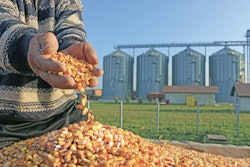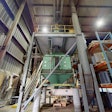
Grain can be stored in many types of facilities, but all storage options must keep the grain dry and provide adequate aeration to control the grain’s temperature.
Grain must be dry and cool (near the average outdoor temperature) when placed in alternative storage facilities because providing adequate, uniform airflow to dry grain or cool grain coming from a dryer is not feasible.
Structural Issues
Grain pushing against walls can damage buildings not built for grain storage. The wall must be anchored securely, and its structural members must be strong enough to transfer the force to the building poles or support structure without breaking or excessive bending.
Typically, you’ll need additional poles and a grain wall to support the grain force in a pole building. Hire an engineer to complete a structural analysis, or have a contractor follow exactly the building company recommendations to prevent a structural failure.
Before placing grain in a building previously used for grain storage, look for anything out of alignment, such as wall bowing and distortions in the roofline. Bowing or bending indicates the load on the building exceeded the load for which it was designed and built. This weakens the structure. Also examine connections for separation or movement and add a gusset or splice to reinforce the connection if necessary.
Storing in Bags
Storing grain in poly bags is a good option, but it does not prevent insect infestations or mold growth in damp grain. Place grain in the bag at recommended storage moisture contents based on grain and outdoor temperatures during the potential storage period.
Heating will occur if the grain exceeds a safe storage moisture content and it cannot be aerated to control heating. Dry grain’s average temperature will follow the average outdoor temperature.
How to store in bags:
- Select an elevated, well-drained site for the storage bags. Run the bags north and south so solar heating is similar on both sides. Sunshine on just one side heats that side, which can lead to moisture accumulation in the grain and spoilage on the cool side.
- Monitor the bags for damage. Wildlife can puncture the bags, allowing moisture in, which can lead to spoilage and the grain smell being released, which attracts more wildlife.
- Monitor the grain temperature at several places in the bags.
- Never enter a grain bag because it is a suffocation hazard. If unloading the bag with a pneumatic grain conveyor, the suction can “shrink wrap” a person.
Grain Piles
Aeration and wind blowing on the pile will not dry wet grain adequately to prevent spoilage.
Grain frequently is stored short term in outdoor piles. However, precipitation is a severe problem for uncovered grain because grain is very porous. A 1-inch rain will increase the moisture content of a 1foot layer of corn by 9 percentage points. This typically leads to the loss of at least a couple of feet of grain on the pile surface, which is a huge loss.
For example, a cone-shaped pile 25 feet high contains approximately 59,000 bushels of grain. Losing just 1 foot of grain on the surface is a loss of about 13 percent of the grain, or $39,000 if the grain value is $4 per bushel and $78,000 at $8 per bushel.
Aeration and wind blowing on the pile will not dry wet grain adequately to prevent spoilage.
Use a cover to prevent water infiltration. Drainage is critically important in grain storage. About 25,000 gallons of water will run off an area about 100 by 400 feet during a 1-inch rain. This water must flow away from the grain and the area next to it. When determining a location for a pile, examine the entire area to assure that flooding will not occur during heavy rains.
Prepare the outdoor ground surface where grain will be piled to limit soil moisture from reaching the grain. The storage floor should be higher than the surrounding ground to minimize moisture transfer from the soil into the grain. Make sure the ground surface is crowned so moisture drains away rather than creating a wet pocket that leads to grain deterioration.
Also look for these issues:
- Anything out of alignment in a bunker or bulkhead wall - Any twisting, flexing or bending of a structural member may lead to a failure.
- Separation or movement in connections
- Material deterioration
Grain Covers
A combination of restraining straps and suction from the aeration system holds grain covers in place. Provide adequate airflow through the grain to control grain temperature. Place perforated ducts on the grain under the cover to provide a controlled air intake for the aeration system and airflow near the cover to minimize condensation problems under the cover.
Place properly sized and spaced ducts under the pile on the ground to pull air through the grain. Some storage options use a perforated wall for the air inlet. Minimize the amount of open area so the air does not “short-circuit” to the fan.
Wind velocity determines the amount of suction you need to hold the cover down. Some control systems measure wind velocity and start fans based on the wind speed. Backup power can hold the cover down during power outages. Make sure the backup power starts when needed.
Cooling Stored Grain
Cool grain with aeration to extend the allowable storage time and reduce the potential for insect infestation. Temperatures below about 60 F reduce insect reproduction. Insects are dormant below about 50 F, and extended exposure to temperatures below about 30 F can kill insects.
Cooling grain as outdoor temperatures cool will reduce moisture migration and the condensation potential near the top of the grain pile. Also, the grain should be cooled because moisture content and temperature affect the rate of mold growth and grain deterioration. The allowable storage time approximately doubles with each 10-degree reduction in grain temperature.

Grain should be cooled whenever the average outdoor temperature is 10 to 15 degrees cooler than the grain. Cool it to near or below 30 degrees for winter storage in northern states and near or below 40 degrees in southern states.
Aeration ducts need to have perforations sized and spaced correctly for air to enter and exit the ducts uniformly and obtain the desired airflow through the grain. The maximum spacing for aeration ducts is equal to the grain depth to achieve acceptable airflow uniformity.
Storing Grain for Another Year
Allowable storage time is cumulative, so consider the amount of storage life remaining when deciding if you can store the grain longer.
For example, if corn were stored at 14 percent moisture and 60 degrees for two months (NovemberDecember), then cooled to 40 degrees for four months (January-April), then stored through the summer months (May-August) at 70 degrees, approximately 90 percent of the storage life has been used. That means very little expected allowable storage life remains if the grain is going to be stored for another
year. Grain going into storage for a second year needs to have been kept cool and dry during the first year and have few broken or cracked kernels.
For more information, contact your local extension office orNDSU grain drying and storage online.
Information provided by North Dakota State University.





















